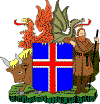|
Iceland flagDescription: Iceland flag, the national flag of Iceland is a sky-blue rectangle with a snow-white cross and a fiery-red cross in the middle of the white cross. The proportional figures for the width and length of the rectangle are 18:25. The arms of the crosses extend entirely to the edges of the flag. The width of the white cross is 2/9 and that of the red cross 1/9 of the width of the flag. The blue field is thus divided into four rectangles, the two nearest to the Iceland flag -pole being squares (equilateral rectangles), the other two being of the same width as the squares, but twice as long. The split Iceland flag (swallow-tail flag) is used by the Government, the Althingi, other official institutions, and representatives of the Foreign Service abroad, including honorary consuls. The split-flag differs from the ordinary national flag in the following: The outer blue fields are three times as long as the squares near the flagpole. It has a slit which is cut in straight diagonal lines from the outer corners of the flag towards its horizontal median; these lines cut the inner horizontal edge of the outer rectangles at a distance from their inner vertical edge which is 3/7 of the length of these rectangles; however, the diagonal lines do not extend fully to the horizontal median of the flag; where they meet the arm of the red cross it is cut athwart by a straight line. Other types of Iceland flag are the flag of the President of Iceland, the post- and telegraph flag and the customs flag. All three are split-flags with different signs on them. The colours are based on the Scotdic textile colour codification as follows: (a) The blue colour: Scotdic No. 693009; Consuls may acquire samples of the Iceland flag colours from an Icelandic embassy or the Ministry for Foreign Affairs. Use of the Iceland flag by consuls. See Article 44 (6). Official Iceland flag days. Official Iceland flag days are the following: (a) Birthday of the President of Iceland Handling of the Iceland flag. Detailed stipulations regarding the handling of the Iceland flag are set out in a booklet published by the Office of the Prime Minister in 1991. Consuls should take note of the following rules and endeavour to observe them when applicable. (a) Proportion between Iceland flag and pole. When a ground Iceland flag -pole is used, its length should preferably be five times the width of the Iceland flag. If the pole is on a rooftop, the proportions should be 1:3 and if it is on the side of a house at an angle, 1:2,5. (b) Iceland flag time. The Iceland flag should not be raised before seven O'clock in the morning. It should normally be lowered at sunset and should never be kept hoisted after midnight. (c) Flying the Iceland flag at half-mast. When the flag is to be flown at half-mast, it should first be raised to full mast and then lowered until 1/3 of the pole is above the upper edge of the flag. When the flag is flown at half-mast on the occasion of a funeral it should be raised to the top of the flagpole when the funeral is over and flown until evening in honour of the deceased. (d) Various rules. Always when the flag is raised or lowered care should be taken not to let it touch the ground. i. The flag cord should be stretched so that the edge of the flag lies close to the pole; ii. Two or more flags should never be flown on the same pole. iii. If the Icelandic flag is among flags of other nationalities, it should be to the farthest left; iv. If the flag is hung on a wall, it should be fully extended, and the smaller rectangles should turn upwards or to the left; v. When the flag is used beside a rostrum or table, it should always be to the left of the speaker, seen from the audience, or on both sides if there are two flags; vi. The flag may not be used on a rostrum, as a tablecloth or a floor mat, or to cover a statue which is about to be presented; vii. When a coffin is covered with the flag, the cross should be towards the head; viii. The flag should always be stored in a safe place; ix. It is forbidden to fly a flag which is faded, dirty, frayed or damaged in any other way. Such a flag should be repaired without delay or else destroyed by burning. Disrespect to the flag. Misuse of the flag is punishable. The use of the flag is forbidden, i.e., in firm marks, trademarks, on sales goods, packaging or in advertisements. However, changes in these stipulations have been under discussion in the Althingi. The use of the flag is also forbidden in private emblems for persons, companies, institutions, etc. When a consul learns of the misuse of the Icelandic flag, he shall notify an Icelandic embassy or the Ministry for Foreign Affairs in Reykjavik (see Article 54 of this Manual). History of Iceland flagFrom 1350 to 1896
1897
A meeting was called and a resolution protesting against the action of the captain was adopted. The resolution also called for the official adoption of a flag for Iceland. The parliament wanted the blue and white cross flag, but this was denied by Danish authorities, apparently because the King thought this flag to be too similar to the royal flag of Greece. The new flag of 1915 had a blue field with a red cross bordered in white. It is this flag that is used today. The design was proposed by Matthias Thordarson. He explained the colours as blue for the mountains, white for ice and red for fire (Iceland has much volcanic activity). Though the King had agreed that the Icelanders had the right to a flag, he declined to accept the blue-white-red flag at first. However, a Royal decree of 19 June 1915 allowed the flag to be used on land, but restricted the use at sea to local waters. The flag was officially accepted by the king 30 November 1918 and adopted by law as the national flag the same day. It was first hoisted (as a state ensign) 1 December 1918. On this day Iceland became a separate kingdom united with Denmark under one king. Although the pattern is the same as the modern flag, note that the shade of blue has changed. Originally, the flag was described as "sky blue (ultramarine blue)", a light blue shade. When legalisation was enacted in 1944, the ultramarine specification was dropped, and the shade of blue got darker.The National Museum of Iceland has the original flag that was flown on Iceland's Independence Day on the 18th of December 1918. Icelands coat of arms (Icelands shield )
|




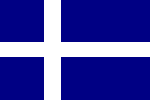
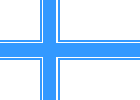 Alternate proposal of 1914
Alternate proposal of 1914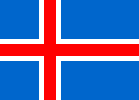 The flags of 1915
The flags of 1915 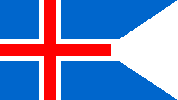 State Flag and Ensign (1915)
State Flag and Ensign (1915)